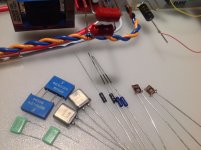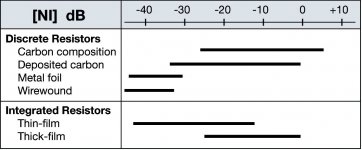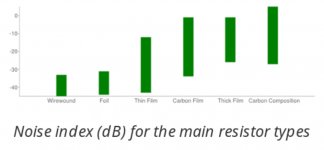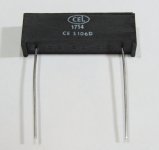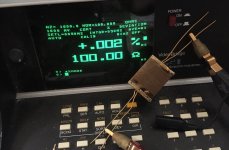Are you saying that resistors cannot produce noise and distortion? If so, this is completely false. All resistors produce thermal noise; most resistors produce some excess noise too, which depends on many factors but often include current. In some cases an I/V resistor will have a standing current. All resistors are slightly nonlinear, but most are so close to linear that they can be regarded as linear for almost all purposes; the big exception is carbon comp which is much worse than other type (and noisy too).diyralf said:Noise and distortion come from a bad circuit design and not from resistors of whatever kind.
Maybe I misunderstood you?
Not every resistors materials and technology are equal and all types have different specyfications  Best regards
Best regards
Attachments
....A metal film resistor for 2 cent should do the business....
A ~ 22 cent's Dale CMF can do with less noise

I use the Charcroft CE-S106D 2w in my 16 stack DDDAC. I have tried the AN Tantalum 2w, Kiwame 2w which all work fine but the Charcroft is much better and is designed for very low noise and high temperature stability.
Expect to hear a lot more low level detail and tight imaging.
Expect to hear a lot more low level detail and tight imaging.
Attachments
Why should a Dale have less or more noise? Where is the connection? This must be a new physical formula unknown to me: noise = f (resistor, money)A ~ 22 cent's Dale CMF can do with less noise
Resistors made with high quality materials and final product tech laboratory controls make difference.
Imo not the best but better for audio applications at affordable price.
https://www.mouser.fr/datasheet/2/427/cmfind-239942.pdf
Imo not the best but better for audio applications at affordable price.
https://www.mouser.fr/datasheet/2/427/cmfind-239942.pdf
Attachments
I saw 0.1uV/V noise in the data sheet. What is the noise of a standard metal film res? Let's say 1uV/V. All beyond -120dB. I do not think anyone in the world can hear that. For me, this is the money waisting. It is always more effective if you design the circuit well instead of using strange components.
Last edited:
I saw 0.1uV/V noise in the data sheet. What is the noise of a standard metal film res? Let's say 1uV/V. All beyond -120dB. I do not think anyone in the world can hear that. For me, this is the money waisting. It is always more effective if you design the circuit well instead of using strange components.
If they are happy wasting spending money, do you think lacing science with personal sentiments is going to change their opinion? You've already had to change your angle of approach within the last few posts. First there was no noise, and now you've seen noise in the datasheet. If you really want to change people's views and/or be a martyr for not spending money on boutique components, you should take the time to construct an argument that doesn't cast doubts over your understanding of the subject.
Last edited:
I use the Charcroft CE-S106D 2w in my 16 stack DDDAC. I have tried the AN Tantalum 2w, Kiwame 2w which all work fine but the Charcroft is much better and is designed for very low noise and high temperature stability.
Expect to hear a lot more low level detail and tight imaging.
I use TX2575 from the Texas Components Corp. Is the Charcroft CE-S106D the same type of the resistor construction/material (made by Vishay), but encapsulated in plastics?
a good metaphor!... money on boutique components
I use TX2575 from the Texas Components Corp. Is the Charcroft CE-S106D the same type of the resistor construction/material (made by Vishay), but encapsulated in plastics?
Bulk foil resistors exist in a bewildering array of types and styles of packaging. I don't really like the 'naked' style of construction, it's not very robust.
Vishay makes the metal foil (tightly patented) and sells it to various manufacturers who build the finished product. Most are standardized construction meeting various milspecs. At this level of stability and precision, the entire package and every construction detail exists in order to meet those specifications.
Going by specification alone, bulk foil resistors are almost the most stable and precise resistors available--especially the Z foil formulation. However, a high quality wirewound resistor can run a close second. The better metal film resistors are not far behind, such as Vishay Dale PTF. I use them when I can afford them, which is not often. Usually I employ 100 ppm or better metal film, the lower the temperature coefficient the better. Nickel-chromium alloys are the most common material used, but there are some others; bulk foil uses proprietary nickel-chromium alloys but is significantly thicker than films, which can be extremely thin and subject to greater voltage coefficients.
Tantalum resistors (tantalum nitride?) have a similar good reputation, but finding detailed specifications and documentation is almost impossible and thus I don't trust them. I don't like any sort of carbon resistor because they're inherently unstable, including film. At one time, 1% carbon film resistors were available but was long ago replaced by metal film.
Metal oxide falls into a vague middle ground between metal film and carbon film but make good power resistors and general purpose resistors, with better long-term stability than carbon composition.
The rest is up to the individual's subjective tastes, and understanding how to use a specific part in a specific design to its best advantage.
I could wish for volume control potentiometers made of metal foil, but Vishay must think there is no market for that style of construction. Foil itself may not work well for mechanical wear reasons.
Yes, it appears to be unknown to you that while resistor thermal noise is the same for all resistors of the same value at the same temperature this is not true for excess noise: this depends on exactly how the resistor is made, which materials are used, what their quality is etc. Now in many cases the difference may be too small to be noticed, but to think that there is no difference just shows ignorance about components.diyralf said:Why should a Dale have less or more noise? Where is the connection? This must be a new physical formula unknown to me: noise = f (resistor, money)
I am sure that in most cases people spending a lot of money on resistors are merely chasing the warm glow which they get from spending money and telling others what they have spent, but in some cases the expensive resistors are actually better (but probably unnecessarily so).
Bikes and Ferraris are equally good as vehicles for buying bread. However, people do not necessarily look stupid in either. Ferraris are faster than bikes, but also more expensive. Some people buy them because they are faster; some because they are more expensive.
In the same way, some people use a bike because it is cheap; some because they wanbt to keep fit; some because they want to be seen to be making a statement about saving the planet.
In the same way, some people use a bike because it is cheap; some because they wanbt to keep fit; some because they want to be seen to be making a statement about saving the planet.
Last edited:
I use TX2575 from the Texas Components Corp. Is the Charcroft CE-S106D the same type of the resistor construction/material (made by Vishay), but encapsulated in plastics?
I think it is similar in construction but the S106D`s from Charcroft have a higher power handling
Bikes and Ferraris are equally good as vehicles for buying bread. However, people do not necessarily look stupid in either. Ferraris are faster than bikes, but also more expensive. Some people buy them because they are faster; some because they are more expensive.
In the same way, some people use a bike because it is cheap; some because they wanbt to keep fit; some because they want to be seen to be making a statement about saving the planet.
Hi actually not.
Bicycle has the best ratio in terms of input Jules for produced work. I think 1:7.
So You can drive a bike with one cube of sugar energu with a distance that no engine can beat with same input energy
I am not sure whether you have invented perpetual motion, or simply not counting the huge energy input from the Sun.Zoran said:For 1 calory input outcome is 5 cal.
- Status
- This old topic is closed. If you want to reopen this topic, contact a moderator using the "Report Post" button.
- Home
- Source & Line
- Digital Source
- Best resistors For I/V Conversion?
